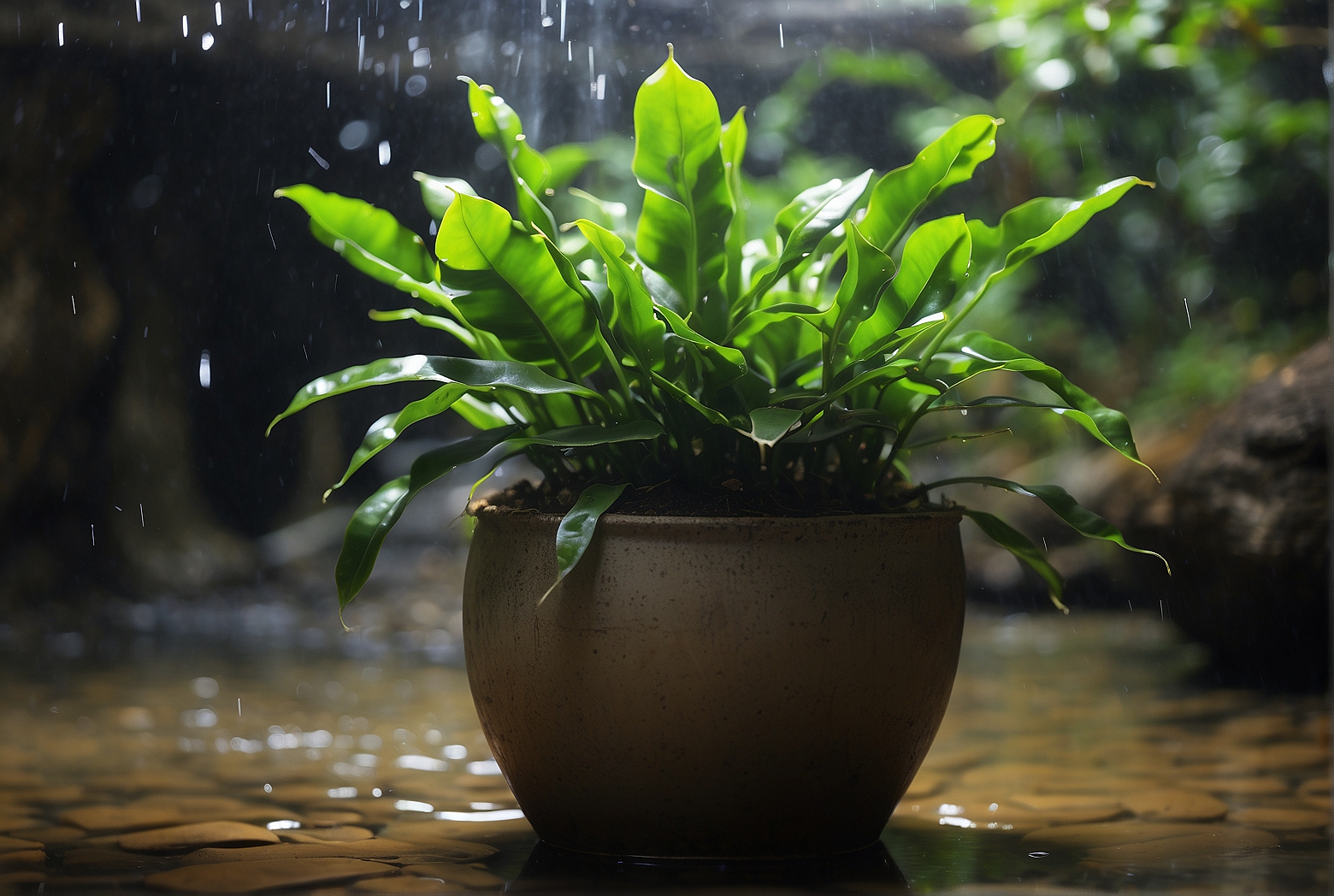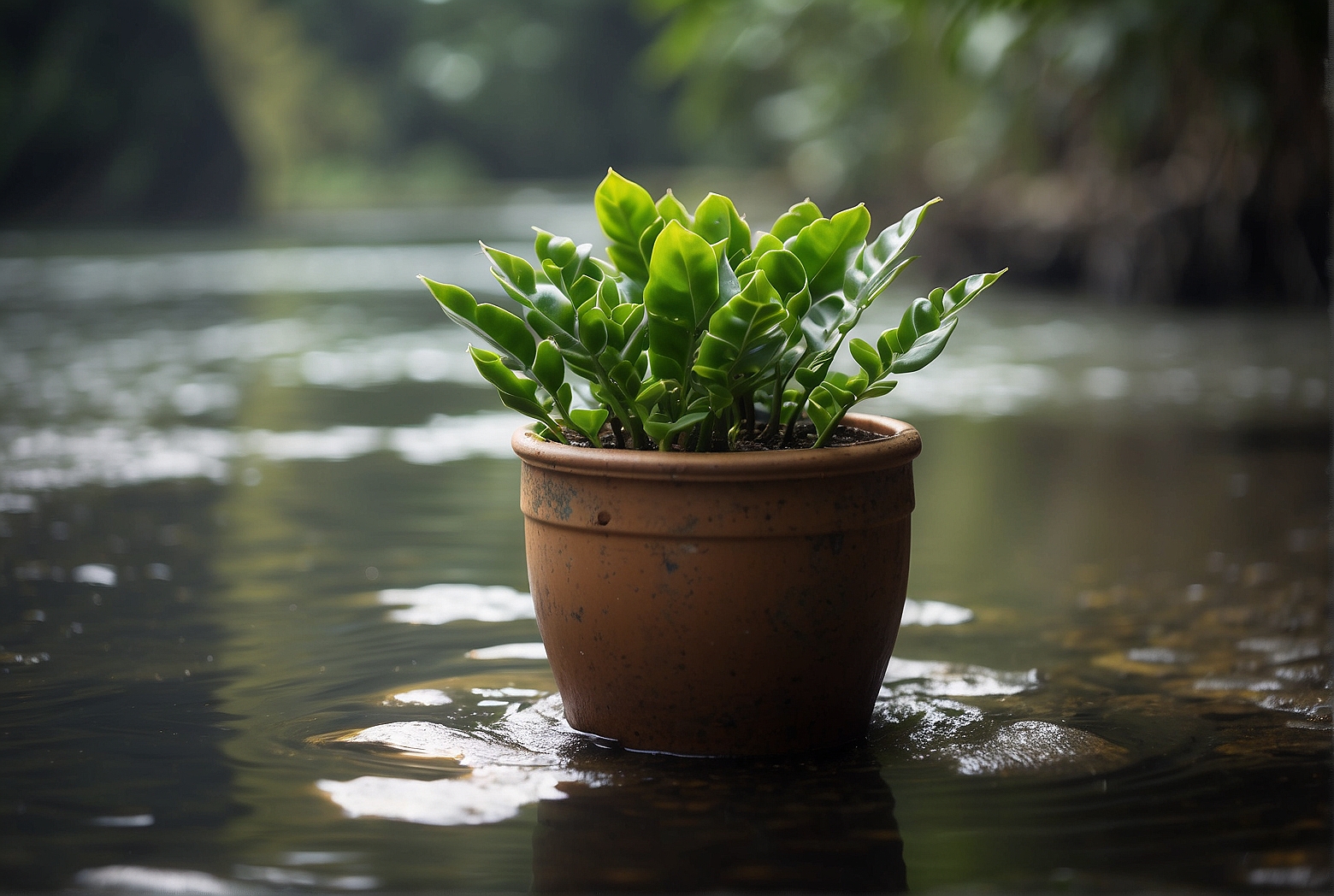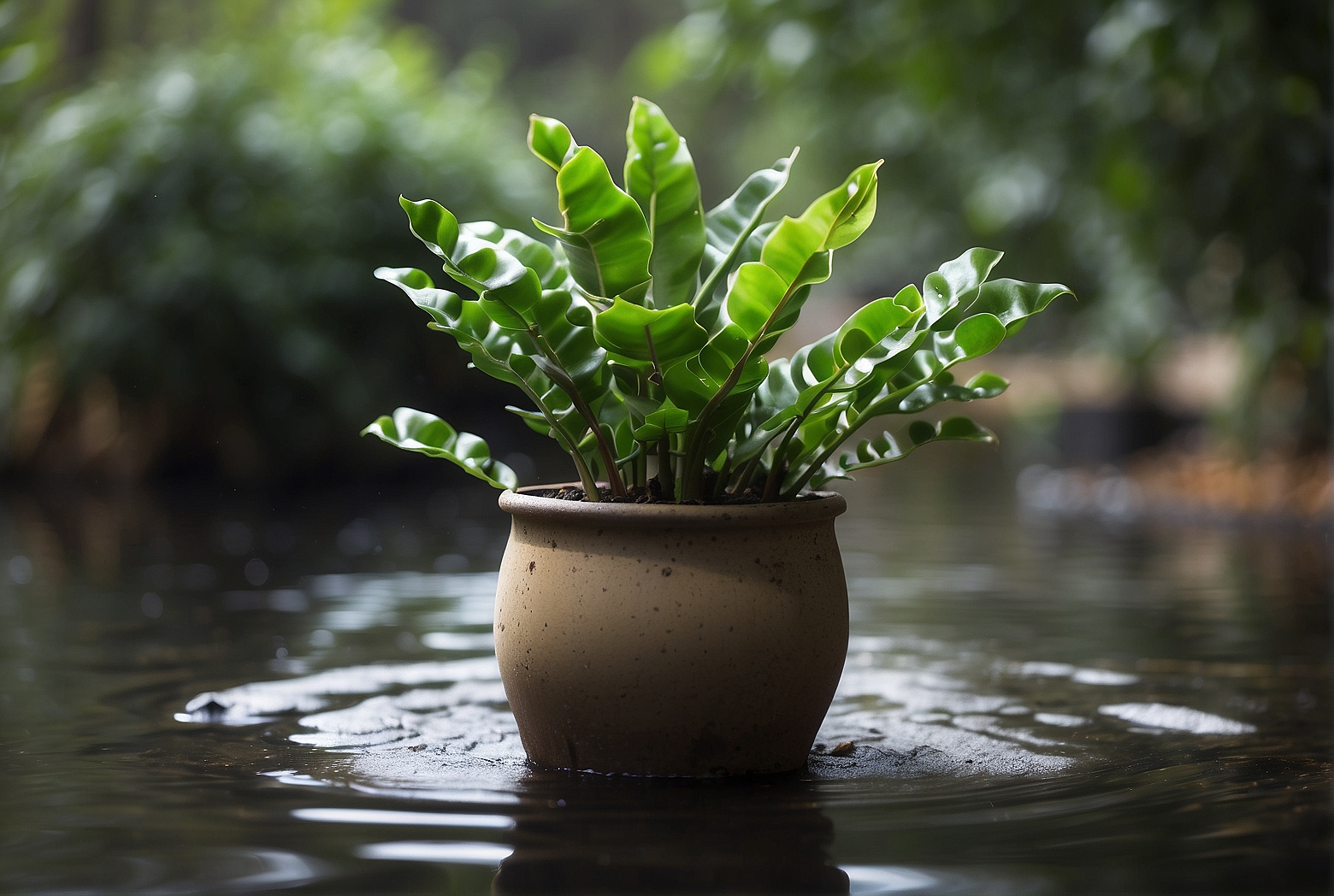Last Updated on April 10, 2024 by Tony Manhart
Imagine having a lush and vibrant ZZ plant thriving effortlessly in your home, without the hassle of traditional soil-based gardening. Curiosity piqued? You’ll be pleased to know that the possibility of ZZ plants growing in water permanently is indeed a reality. This hardy and versatile plant, known for its glossy green leaves and natural resilience, has the potential to flourish in water, providing an alternative and visually striking way to cultivate these popular indoor plants. In this article, we will explore the feasibility and benefits of growing ZZ plants in water, as well as delve into some essential tips to help you achieve success in this unique endeavor. So, sit back, relax, and prepare to embark on an exciting journey into the world of water-grown ZZ plants!
Introduction to ZZ Plant
Welcome to the world of ZZ plants! This article will serve as your comprehensive guide to growing ZZ plants in water. From their characteristics to common care guidelines, we’ll cover all the essential aspects of cultivating these beautiful plants hydroponically.
Overview of ZZ Plant
The ZZ plant, scientifically known as Zamioculcas zamiifolia, is a popular choice among indoor plant enthusiasts. With their glossy, dark green foliage and exotic appearance, ZZ plants bring a touch of the tropics into your home. These plants are native to Eastern Africa and are well-known for their ability to thrive in low-light conditions, making them an ideal choice for indoor environments.
Characteristics of ZZ Plant
ZZ plants are characterized by their thick, waxy leaves that grow in a sleek, erect manner. These leaves are composed of several pairs of leaflets arranged along a central stem, giving the plant a unique and appealing aesthetic. One of the most attractive features of ZZ plants is their ability to store water within their rhizomes, which allows them to withstand periods of drought.

Common Care Guidelines
Before we dive into the specifics of growing ZZ plants in water, let’s discuss some general care guidelines that apply to both soil and water cultivation. ZZ plants prefer bright, indirect light, but they can tolerate low-light conditions, making them ideal for those with limited access to sunlight. When it comes to watering, ZZ plants prefer to dry out between waterings, as they are highly susceptible to root rot if overwatered. Additionally, these plants thrive in average room temperatures between 65°F and 75°F (18°C and 24°C).
Growing ZZ Plant in Water
Can ZZ Plant Grow in Water?
Yes, ZZ plants can indeed grow in water! While they are commonly grown in soil, ZZ plants have the remarkable ability to adapt to different growing mediums, including water. Growing these plants hydroponically can be an exciting and rewarding experience for any plant enthusiast.
Benefits of Growing ZZ Plant in Water
Growing ZZ plants in water offers several advantages. Firstly, it allows you to closely monitor the plant’s water needs as you can easily visualize the water level. Secondly, it eliminates the risk of overwatering, which is a common problem with ZZ plants grown in soil. Lastly, growing ZZ plants in water can be an aesthetically pleasing addition to your home, as their unique roots are showcased without the constraints of soil.
Requirements for Growing ZZ Plant in Water
To successfully grow a ZZ plant in water, you need a few essential requirements. Firstly, choose a healthy ZZ plant with robust leaves and a well-established root system. Ideally, select a ZZ plant that is already growing in soil, as it will have a greater chance of adapting to water cultivation. Secondly, ensure that you have a container suitable for water cultivation, such as a glass vase or a hydroponic reservoir. Lastly, you’ll need to provide the plant with clean, filtered water of the appropriate temperature and essential nutrients to support its growth.

Choosing the Right ZZ Plant
Selecting Healthy ZZ Plant
When choosing a ZZ plant for water cultivation, it is crucial to select a healthy specimen. Look for plants with vibrant green leaves that are free from discoloration, spots, or yellowing. Avoid plants with wilted or drooping leaves, as this may indicate underlying issues. Additionally, examine the roots of the plant. Healthy ZZ plants should have firm, white roots that show no signs of rot or decay.
Considerations for Propagating ZZ Plant in Water
If you already have a ZZ plant and want to propagate it in water, there are a few considerations to keep in mind. Choose a mature ZZ plant with healthy rhizomes and select a stem cutting with at least two leaf sets. Ensure that the cutting is about four to six inches long for optimal success. Propagating ZZ plants in water can be a rewarding way to expand your plant collection or share with fellow plant enthusiasts.
Preparing the Water for ZZ Plant
Choosing the Container
When preparing the water for your ZZ plant, selecting the right container is crucial. Opt for a transparent container that allows you to easily observe the water level and the growth of the roots. Glass vases or hydroponic reservoirs are great options. Make sure the container is tall enough to accommodate the ZZ plant’s root system comfortably.
Water Quality and Temperature
High-quality water is essential for the successful growth of your ZZ plant. Use filtered or purified water to provide the cleanest, contaminant-free environment for your plant’s roots. Additionally, maintain the water temperature between 65°F and 75°F (18°C and 24°C) to mimic the plant’s preferred growing conditions. The ideal water temperature promotes healthy root development and overall plant growth.
Adding Nutrients to the Water
ZZ plants require sufficient nutrients even when grown in water. While the plant can derive some nutrients from the air, supplementing with a balanced liquid fertilizer can promote healthier growth. Choose a fertilizer specifically formulated for hydroponic plants and follow the instructions provided by the manufacturer. Avoid over-fertilization, as this can lead to nutrient burn and hamper the plant’s growth.
Transferring ZZ Plant to Water
Transferring ZZ Plant from Soil to Water
If you already have a ZZ plant growing in soil and wish to transfer it to water, follow these steps. Carefully remove the plant from its pot, taking care not to damage the roots. Gently shake off excess soil and trim any excessively long or damaged roots. Place the plant in the prepared container with clean water, ensuring that the roots are submerged. Add more water if necessary, ensuring that the base of the stem remains above the water level.
Root Trimming and Pruning
When transferring a ZZ plant to water, root trimming and pruning are vital steps for optimal growth. Trim any excessively long or damaged roots to promote new growth. It is also advisable to prune any yellowing or dead leaves to maintain the plant’s overall health and appearance. Regular root trimming and pruning will help your ZZ plant thrive in its new water environment.
Planting ZZ Plant Cuttings in Water
If you are propagating ZZ plant cuttings in water, the process is slightly different. After selecting a healthy cutting, remove the lower leaf set, leaving only the top two sets intact. This will prevent the lower leaves from being submerged in water, which can lead to rot. Place the cutting in the container, ensuring that the lower leaf nodes are submerged while keeping the upper leaves above the water surface. The cutting will develop new roots, and eventually, grow into a mature ZZ plant.
Caring for ZZ Plant in Water
Monitoring Water Levels
Maintaining the correct water level is crucial when caring for a ZZ plant grown in water. Regularly monitor the water level and ensure that the roots remain consistently submerged. Add water as necessary to maintain the desired level. However, be cautious not to overfill the container, as this can lead to stagnant water and root rot.
Light Requirements
While ZZ plants can tolerate low-light conditions, providing them with bright, indirect light will encourage optimal growth. Place your ZZ plant near a window with filtered sunlight or several feet away from a well-lit artificial light source. Avoid exposing the plant to direct sunlight, as this can scorch the leaves and damage the plant.
Fertilizing ZZ Plant in Water
In addition to clean water, ZZ plants in water cultivation require regular fertilization. Use a balanced liquid fertilizer formulated specifically for hydroponic plants. Follow the instructions provided by the manufacturer to ensure the appropriate dosage. Fertilize your ZZ plant every four to six weeks during the growing season, reducing this frequency during winter when the plant’s growth slows down.
Preventing Water-related Issues
Water-related issues such as root rot and fungal diseases can occur when growing ZZ plants in water. To prevent these problems, avoid overwatering and ensure that the water is regularly refreshed. Stagnant water can create a breeding ground for pests and diseases. If you notice any signs of root rot or pests, take immediate action to rectify the issue and provide a healthier environment for your ZZ plant.
Common Challenges and Solutions
Yellowing Leaves
If your ZZ plant’s leaves start to turn yellow, there may be an underlying issue. The most common cause of yellowing leaves in ZZ plants is overwatering or inadequate drainage. Check the water level and adjust accordingly. If the roots are waterlogged, consider repotting the plant in fresh, well-draining soil or trimming the affected roots before transferring it back to water.
Root Rot
Root rot can occur if the ZZ plant’s roots are consistently submerged in water or the water is stagnant. To prevent root rot, ensure that the water level is appropriate, and refresh the water regularly. If root rot is already present, trim the affected roots and repot the plant in fresh water and a well-draining container. Adjusting the care routine and avoiding overwatering will help prevent future occurrences.
Pests and Diseases
While ZZ plants are generally resilient to pests, they can occasionally face challenges. Common pests that may affect ZZ plants include mealybugs, spider mites, and scale insects. Observe your plant regularly for signs of infestation such as webbing, sticky residue, or tiny crawling insects. Treat infestations with appropriate plant-safe pesticides or natural remedies, ensuring thorough coverage of the affected areas.
Transitioning ZZ Plant from Water to Soil
When and Why to Transition
Transitioning a ZZ plant from water to soil may be necessary for various reasons. You may choose to transition to soil if the plant is outgrowing its water container or if you prefer a more traditional planting method. Additionally, some ZZ plant enthusiasts believe that transitioning to soil can result in more robust and faster growth. However, only consider transitioning if your ZZ plant is healthy and showing signs of vitality.
Steps for Transitioning ZZ Plant to Soil
When transitioning your ZZ plant from water to soil, follow these simple steps. Gently remove the plant from the water, taking care not to damage the roots. Shake off excess water and choose a well-draining potting mix specifically formulated for houseplants. Make a hole in the soil, place the roots of the ZZ plant inside, and cover them with soil. Water the plant thoroughly, allowing excess water to drain away. Continue to care for your ZZ plant according to the general care guidelines for soil-grown ZZ plants.
FAQs about Growing ZZ Plant in Water
Can ZZ Plant Survive in Water Permanently?
While ZZ plants can survive in water for extended periods, it is not recommended to keep them permanently immersed. Over time, the lack of a well-draining medium can lead to waterlogged roots and potentially the onset of root rot. It is advisable to periodically transition the ZZ plant to soil to promote healthy growth and prevent water-related issues.
How Long Can ZZ Plant Stay in Water?
A ZZ plant can stay in water for several months, depending on various factors such as water quality, temperature, and the overall health of the plant. Regularly monitor the plant’s root health and consider transitioning it to soil after a few months. This allows the plant to rejuvenate and access nutrients from a different medium.
Can ZZ Plant be Grown in Semi-Hydroponics?
Yes, ZZ plants can also be grown in semi-hydroponics. Semi-hydroponics, also known as passive hydroponics, involves growing plants in a hydroponic system without the need for circulating water. The roots of the plant are partially submerged in a water reservoir, allowing the plant to take up moisture and nutrients as needed. Semi-hydroponics can be a viable option for ZZ plants, as it provides a balance between the benefits of hydroponics and the stability of soil-based cultivation.
Conclusion
In conclusion, growing ZZ plants in water can be a fascinating and rewarding experience. From their unique characteristics to transplanting and caring for them, this article has covered all aspects of cultivating ZZ plants hydroponically. Whether you choose to propagate ZZ plants in water or transition them from soil, these versatile plants are sure to thrive and bring a touch of nature into your indoor space. Remember to follow the common care guidelines, monitor water levels, and provide the required nutrients to ensure your ZZ plant remains healthy and vibrant. Happy growing!
Tony Manhart is a passionate gardener who has been tending to gardens for over 20 years. He takes pride in creating beautiful outdoor spaces with plants, trees, and shrubs that can thrive in any environment. He loves to share his knowledge with others and has taught classes on gardening basics and advanced techniques. He is committed to sustainability, using natural and organic methods to create and maintain gardens. He also works with local organizations to create green spaces for communities. When he’s not gardening, Tony enjoys hiking, reading, and spending time with his family.


